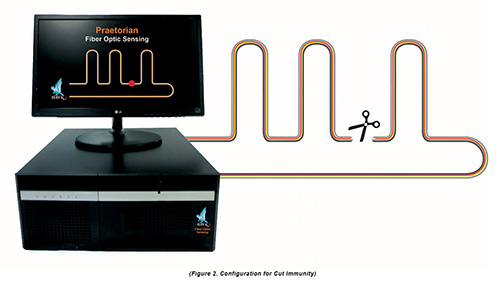The Ultimate Guide to Fiber Optic Safety And Security Solutions for Your Organization
In an era where safety and security concerns are extremely important for organizations, comprehending the details of fiber optic technology can be transformative. This guide describes just how integrating fiber optic safety and security systems not only boosts information defense but also provides benefits like resistance to disturbance and real-time tracking capabilities.
Recognizing Fiber Optic Technology

The core of a fiber optic cord is composed of a thin glass or plastic center, bordered by a cladding layer that shows light back into the core. Single-mode fibers are designed for long-distance transmission, while multi-mode fibers are suitable for shorter distances, commonly used within structures.
Optical fiber are not just faster yet also extra safe than typical electrical wiring. Their intrinsic resistance to electro-magnetic interference and the difficulty of taking advantage of the signal without detection make them a preferred option for businesses focusing on data honesty and protection. As companies increasingly depend on secure and efficient interaction systems, recognizing fiber optic innovation ends up being necessary for informed decision-making.
Secret Benefits of Fiber Optic Safety
When thinking about safety options for a service, the advantages of fiber optic systems are particularly engaging. Fiber optic technology provides phenomenal information transmission speeds and bandwidth capability, making it optimal for managing high-resolution video clip feeds from security cameras. This capability makes sure that safety and security workers receive real-time data, enhancing general feedback times to potential protection threats.
In addition, fiber optic cables are naturally resistant to electromagnetic disturbance, which can jeopardize the stability of typical copper-based systems. This resistance ensures that the information transferred remains protected and nonstop, offering an extra trustworthy protection facilities. Furthermore, optical fiber are less at risk to physical damages, as they are made from glass instead than metal, decreasing upkeep prices and downtime.
Fiber optic systems offer improved cybersecurity features, including encryption abilities that safeguard delicate data from unauthorized access. Collectively, these advantages make fiber optic security systems a robust option for organizations seeking to enhance their security actions.
Installment Process and Factors To Consider
Considering the intricacies entailed, the setup procedure of navigate to these guys fiber optic security systems calls for mindful planning and execution. The initial step includes a comprehensive website analysis to determine optimal locations for cabling and equipment. This assessment should take into consideration ecological variables, existing facilities, and possible susceptabilities.

Additionally, the installation must abide by regional building ordinance and sector standards. This might include coordinating with numerous stakeholders such as building supervisors, IT groups, and protection workers to make certain seamless combination with existing systems.
Post-installation, extensive screening is necessary to validate system efficiency and determine any issues that may develop. By prioritizing these considerations during the installment process, organizations can make sure a robust and effective fiber optic safety and security system that satisfies their specific safety requirements.
Newest Technologies in Fiber Optic Security
Current innovations in fiber optic technology have significantly improved the capacities of safety and security systems for companies. Among one of the most remarkable technologies is the combination of fiber optic sensors that can spot resonances and breaches along the border of a center. These sensors supply real-time monitoring, allowing fast response to possible breaches.
In addition, the growth of distributed fiber optic noticing innovation enables the constant surveillance of big locations with a solitary fiber cable. This technique not only lowers setup expenses yet additionally enhances the dependability of keeping track of systems by removing the requirement for multiple, different sensing units.
Moreover, improvements in multiplexing methods have actually made it possible for companies to transmit vast quantities of information over fiber optic networks, improving the capacities of video clip security systems. High-definition video feeds can currently be sent over fars away without loss of high quality, ensuring that security employees have accessibility to clear and actionable information.
Last but not least, the usage of artificial intelligence (AI) combined with fiber optic systems is revolutionizing hazard discovery. AI formulas can examine information from fiber optic networks to determine uncommon patterns or actions, allowing for proactive safety actions. These developments collectively stand for a significant jump forward in fiber optic protection technology.
Choosing the Right System for Your Organization
Picking the ideal fiber optic protection system for your company is important for making certain ideal protection and satisfaction. To make an enlightened choice, assess your particular security requirements, taking into consideration variables such as the size of your premises, the nature of your operations, and prospective helpful site susceptabilities.
Begin by examining the degree of safety and security required; as an example, high-risk settings might require innovative systems with incorporated monitoring and intrusion discovery capabilities. Next, take into consideration scalability; special info as your organization grows, your safety system ought to be capable of expanding to suit enhanced needs without considerable overhauls.
Additionally, investigate the dependability and performance of various systems. Seek carriers with well established online reputations and customer reviews that vouch for their solution quality. It's also a good idea to inquire about the modern technology's compatibility with existing framework, making certain a smooth assimilation procedure.
Conclusion
In final thought, fiber optic safety and security systems present a robust solution for improving organization security facilities. The most current advancements even more bolster the performance of these systems, guaranteeing that services remain safe and secure and versatile in an ever-evolving threat landscape.